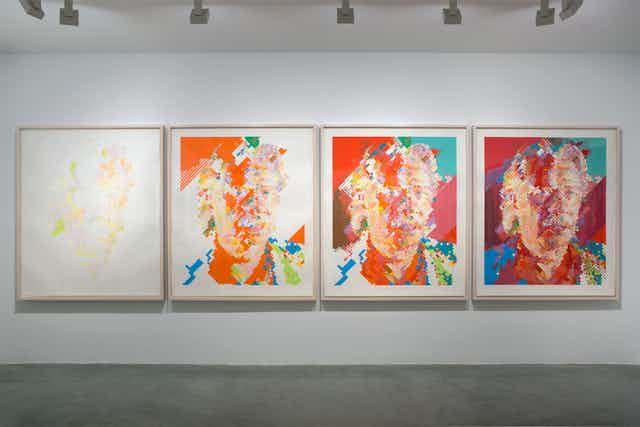With more than 200 prints on display, Chuck Close: Prints, Process and Collaboration is one of the biggest printmaking exhibitions to be held in Australia. The whole top floor of Sydney’s Museum of Contemporary Art (MCA) has been given over to this show.
Very early in his career, Chuck Close was provoked by a comment made by the most prominent art critic of the day in America, Clement Greenberg, that it was impossible to paint a face. As Close asserted in 1968, portraiture appeared as the “dumbest, most moribund, out-of-date and shop-worn of possible things you could do”.

Process-driven portraits
Between 1967 and 1970 Close produced a series of eight huge painted black and white portraits, which in meticulous detail reproduced every nuance of the face of his sitter as recorded in the photograph he made with his large box camera. These gridded paintings on gessoed ground were executed with black paint, with a limited application of white highlights.
Close sought fidelity not so much with the features of the sitter, but with his photograph.
One of the paintings from this series, Bob, 1970, was acquired by James Mollison in 1975 for the National Gallery in Canberra. That is the opening work in the current exhibition. From it, we learn very little about the personality of the stage-set designer, the sitter Robert Israel, or for that matter about the nature of portraiture, but a lot about image, perception and process.
It is this conceptual concern that Close brought to his printmaking. This process-driven artist, who is obsessed with recording every change in the development of work, could take trail proofs or state proofs at every stage in the realisation of the work.

The mezzotint, Keith (1972) based on a photograph of a fellow artist, Keith Hollingworth, was developed by Close in collaboration with Kathan Brown at Crown Point Press, in Oakland California. Again it was Mollison who in 1976 had the foresight to acquire the mezzotint, all 19 progressive trial proofs, as well as the actual copper plate.
At this exhibition, these are being exhibited as a group for the first time. The mezzotint is a most painstaking technique. Unlike most of the normal methods in printmaking or drawing, where you make a black line on a white surface, in the mezzotint you work from black, slowly scraping away the roughed-up surface, to create detail and to arrive at white lines against a black background.
Close challenged his master printer and himself by adopting this technique and employing it on an unprecedented scale, in the modern era, of more than a metre for his plate. As you examine the transformations in the trail proofs, there is a grid emerging as a compositional structural element.
What is clear from the Keith mezzotint, as well as all of the series of woodcuts (both Japanese and Western style), linocuts, etchings, colour paper-pulp prints, screenprints, tapestry prints, fingerprints (literally made by his fingerprints) and all different manifestations of digital prints, is that Close is not primarily a photorealist, with whom he is normally grouped, but a conceptual artist, and one who is more than anything else concerned with process.
The event that didn’t change Close’s art
At the age of 48, in 1988, Close’s life changed abruptly as he experienced a catastrophic spinal artery collapse while attending a function in New York. It left him paralysed from the neck down.
Through intensive physio he regained partial control of some of his muscles and has continued to make art, although it was now from a wheelchair with brushes strapped to his hands, assisted by helpers.
The remarkable thing was that “the event”, as Close prefers to call it, did not appear to have had any impact on the style, technique or conceptual framework of his art, but only on the mechanism of its production.
In his 1998 retrospective, which I saw at the Museum of Modern Art in New York, it was impossible to differentiate his work before and after “the event”. The same is true in this major print retrospective curated by Terri Sultan.

The strategy throughout his print oeuvre remains essentially the same: the subject is a photograph, usually the face of a sitter, which is then gridded and subjected to a process of distillation through some printmaking technology and finally realised, frequently on a huge scale.
A common conceptual conceit running throughout all of his prints is a game between the highly personalised pixelated surface apparent in the print, when seen at a close viewing distance, and the hyperrealist illusion created when viewed from a distance.
Additionally, and central to his practice, is the desire to clearly reveal and record all of the stages in the metamorphosis of the image. It is as if the conjurer and alchemist give us privileged access to their world and reveal their bag of tricks, and we still gasp with amazement and disbelief at the final outcome.
Chuck Close has worked with some of the great master printers and printmaking workshops of our time. He has pushed the limits of the humble print from that of an affordable, democratic multiple to that of a huge, mesmerisingly complex and very expensive artwork produced in multiples.
His art is ultimately a celebration of solemn monumentality presented with an American sense of scale.
Chuck Close: Prints, Process and Collaboration is on display at Sydney’s Museum of Contemporary Art until March 15. Details here.

